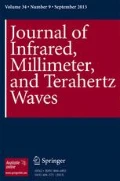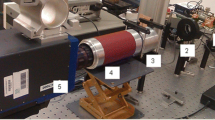Abstract
The impact of the response speed of a microelectromechanical system (MEMS) bolometer on the quality of terahertz (THz) imaging with rapid scan has been investigated and compared with a pyroelectric detector (PED). The imaging system was an active imaging composed of the MEMS bolometer, THz quantum cascade laser, and two-dimensional translation stage. The scanning process of the imaging system consisted of continuous scans in the X direction and step scans in the Z direction. The MEMS bolometer had a beam resonator with a resonant peak of 422 kHz, and it was operated in the frequency modulation detection mode. The frequency shifts in the resonant peak due to the irradiation of the THz waves were tracked using the phase-locked loop system built in the lock-in amplifier. In the measurement of the response characteristics using a 100-μm pinhole, the peak intensity was almost constant against the stage speed in the case of the MEMS bolometer. For the PED, there was a decrease in the peak intensity and delay in the peak positions with increasing stage speed due to the insufficient response speed. When the images were acquired using the MEMS bolometer with a stage speed of 25 mm/s, fine structures of a metal bookmark were clearly observed and no degradation in the resolution was observed with changing stage speed. In the case of the PED, the resolution gradually degraded with increasing stage speed.






Similar content being viewed by others
References
M. Tonouchi, "Cutting-edge terahertz technology," Nat. Photon, 1, 97-105 (2007).
P. Dean, A. Valavanis, J. Keeley, K. Bertling, Y. L. Lim, R. Alhathlool, A. D. Burnett, L. H. Li, S. P. Khanna, D. Indjin, T. Taimre, A. D. Rakic, E. H. Linfield, and A. G. Davies, “Terahertz imaging using quantum cascade lasers – a review of system and applications,” J. Phys. D: Appl. Phys. 47, 374008 (2014)
D. M. Mittleman, “Twenty years of terahertz imaging,” Opt. Express 26, 9417-9431 (2018).
H. Ito, and T. Ishibashi, “InP/InGaAs Fermi-level managed barrier diode for broadband and low-noise terahertz-wave detection,” Jpn. J. Appl. Phys. 56, 014101 (2017).
H. Ito and T. Ishibashi, “Low noise homodyne detection of terahertz waves by zero-biased InP/InGaAs Fermi-level managed barrier diode,” IEICE Electron. Express 14, 1-5 (2017).
R. Han, Y. Zhang, Y. Kim, D. Y. Kim, H. Shichijo, E. Afshari, and Kenneth K. O. “Active terahertz imaging using Schottky diodes in CMOS: array and 860-GHz pixel,” IEEE J. Solid-State Circuits 48, 2296-2308 (2013).
A. Boukhayma, A. Dupret, J. P. Rostaing, and C. Enz, “A low-noise CMOS THz imager based on source modulation and an in-pixel high-Q passive switched-capacitor N-path filter,” Sensors 16, 325 (2016).
N. Oda, S. Kurashina, M. Miyoshi, K. Doi, T. Ishi, T. Sudou, T. Morimoto, H. Goto, and T. Sasaki, “Microbolometer terahertz focal plane array and camera with improved sensitivity in the sub-terahertz region,” J. Infrared Milli. Terahz. Waves 36, 947-960 (2015).
Y. Zhang, Y. Watanabe, S. Hosono, N. Nagai, and K. Hirakawa, “Room temperature, very sensitive thermometer using a doubly clamped microelectromechanical beam resonator for bolometer applications,” Appl. Phys. Lett. 108, 163503 (2016).
Y. Zhang, S. Hosono, N. Nagai, and K. Hirakawa, “Effect of buckling on the thermal response of microelectromechanical beam resonators,” Appl. Phys. Lett. 111, 023504 (2017).
Y. Zhang, S. Hosono, N. Nagai, S.-H. Song, and K. Hirakawa, “Fast and sensitive bolometric terahertz detection at room temperature through thermomechanical transduction,” J. Appl. Phys. 125, 151602 (2019).
I. Morohashi, Y. Zhang, B. Qiu, Y. Irimajiri, N. Sekine, K. Hirakawa, and I. Hosako, “Active THz imaging using MEMS resonator-based bolometer and quantum cascade laser,” th International Conference on Infrared, Millimeter, and Terahertz Waves, We-POS-35 (2018).
Funding
This work was supported by the Collaborative Research Based on Industrial Demand of Japan Science and Technology Agency, KAKENHI from JSPS (15K13966, 19K15023), MEXT Grant-in-Aid for Scientific Research on Innovative Areas “Science of hybrid quantum systems” (15H05868), and the grant from the Precise Measurement Technology Promotion Foundation (PMTP-F).
Author information
Authors and Affiliations
Corresponding author
Additional information
Publisher’s Note
Springer Nature remains neutral with regard to jurisdictional claims in published maps and institutional affiliations.
Rights and permissions
About this article
Cite this article
Morohashi, I., Zhang, Y., Qiu, B. et al. Rapid Scan THz Imaging Using MEMS Bolometers. J Infrared Milli Terahz Waves 41, 675–684 (2020). https://doi.org/10.1007/s10762-020-00691-5
Received:
Accepted:
Published:
Issue Date:
DOI: https://doi.org/10.1007/s10762-020-00691-5




